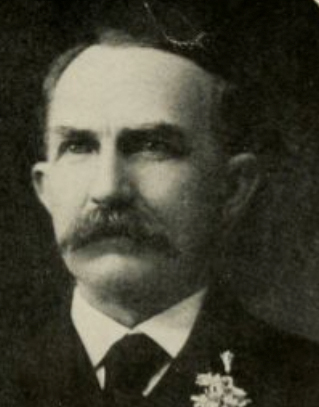
In 1907, Yancey Thomas Ormond effectively distinguished himself as a state senator by lending his support to Sen. James L. Fleming’s (1867-1909) legislation providing for the founding of ECTTS. Ormond was subsequently named a founding member of the East Carolina board of trustees and served in that capacity for fifteen years, from its inception in 1907 until shortly before his passing in 1922. Ormond’s longevity enabled him to have an impact on the growth and development of ECTTS throughout its first decade unmatched by any of the other founders of the school. In the early 1920s as the school’s leaders envisioned for East Carolina a new mission as a teachers college, Ormond strongly supported the transition, lending his cumulative wisdom to the beginning of East Carolina’s next phase as an important center of higher education in the state and region.
Ormond’s support for the teacher training school grew from his own background in education. A native of Greene County with strong ties to the Methodist Church, Ormond first attended a local school in Hookerton before studying at Carolina Seminary, also in Greene County. He completed his early education at Trinity College (later Duke University), graduating in 1878. After returning to Greene County, he taught at Carolina Seminary for two years, and served on the Greene County Board of Education from its founding until 1898, remaining throughout his life an advocate of popular education.
In 1893, he moved to Burlington to teach at an academy that his brother, W. E. Ormond, managed. The following year, he was named principal of the school. In 1897, Ormond earned a license to practice law and soon moved to Kinston where he later served, for a decade, as chair of the Lenoir County Board of Education. His wife, Eugenie Mann, a graduate of Greensboro Female College (later UNC-G), was also a teacher and devoted to the cause of education in the East.
As with Thomas Jarvis (1836-1915), Charles B. Aycock (1859-1912), and a host of other Democratic state leaders of that time, Ormond’s “progressive” support for public education went hand-in-hand with his advocacy of white supremacy and the emerging Jim Crow system of racial segregation. In the 1898 election, he spoke publicly in favor of “the supremacy of the white race in the ‘Old North State.’”
Unlike Jarvis, Fleming, Ragsdale (1855-1914), and others, Ormond initially backed Kinston as the site for the new school. Once Greenville won out, Ormond “became a willing commuter between Kinston and Greenville,” traveling regularly to meet with Jarvis and other founding members of ECTTS board of trustees to realize the school’s legislative mission. From the time of his appointment as a trustee until shortly before his passing, Ormond reportedly never missed a board meeting.
Notably, Ormond was on the board’s committee that officially negotiated the purchase, on April 14, 1908, of the 47.5 acres that became the school’s original campus. Also, all decisions related to architecture, construction, landscaping, equipping, and staffing the new school were made by the working quorum of the Executive Committee: Jarvis and Ormond. Following the passing of Ragsdale (1914) and then Jarvis (1915), Ormond emerged as the senior most leader on the board, working closely with President Robert Wright (1870-1934) to ensure the school’s successful growth and development.
In a 1919 essay, “The School as the Board of Trustees See It,” published on the occasion of the East Carolina’s celebration of its first decade, Ormond pioneered one of the earliest statements of the school’s brief history, crediting Ragsdale as its conceptual father, Jarvis as the force behind its initial construction, and Robert Wright, first president, as the administrative leader who, over a decade of service, transformed the dream of educational uplift into reality. With his essay, Ormond added to the growing historical appreciation for the burgeoning achievements in education made possible by East Carolina’s founding ten years earlier.
Sources:
- Bratton, Mary Jo Jackson. East Carolina University: The Formative Years, 1907-1982. Greenville, N.C.: East Carolina University Alumni Association, 1986.
- “College News and Notes: Death of Mr. Ormond.” Teachers College Quarterly. Vol. IX. April, May, June, 1922. No. 3. P. 259. https://digital.lib.ecu.edu/37035
- “Death of Mr. Ormond.” Teachers College Quarterly. Vol. IX. April, May, June 1922. No. 3. Pp. 303-304. https://digital.lib.ecu.edu/37035
- “Democratic County Convention: Met In the Court House Today.” Daily Free Press (Kinston). April 23, 1898. P. 3.
- “Editorials: Yancey T. Ormond.” Teachers College Quarterly. Vol. IX. April, May, June, 1922. No. 3. P. 259. https://digital.lib.ecu.edu/37035
- Ormond Family Papers (#1180). East Carolina Manuscript Collection, J. Y. Joyner Library, East Carolina University, Greenville, North Carolina, USA. https://digital.lib.ecu.edu/special/ead/findingaids/1180
- “Ormond Funeral at Kinston Thursday: Former State Senator and Prominent Attorney Is Laid To Rest.” News and Observer. March 11, 1922. P. 3.
- “The Kinston Bar: Y. T. Ormond.” Kinston Free Press. September 2, 1899. P. 29.
- Underwood, S. B. “Yancey Thomas Ormond.” Teachers College Quarterly. Vol. IX. April, May, June, 1922. No. 3. Pp. 233-234. https://digital.lib.ecu.edu/37035
- Y. T. Ormond. “The School as the Board of Trustees See it.” Training school quarterly. Vol. VII, no. 1. October, November, December 1919. Pp. 26-29. https://digital.lib.ecu.edu/37025
-
“Yancey T. Ormond Dies; A Prominent Member Local Bar: Former State Senator Passes Away at Home Daughter in Ayden.” Daily Free Press (Kinston). March 9, 1922. P. 1.
Citation Information
Author: John A. Tucker, PhD
Date of Publication: 9/7/2022